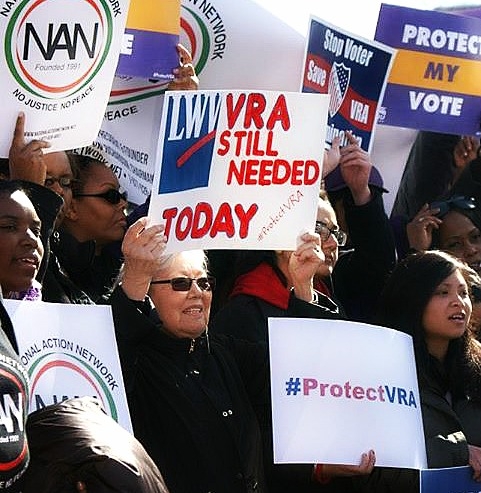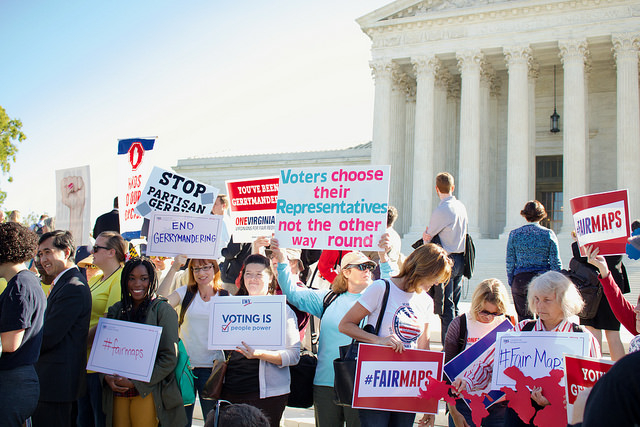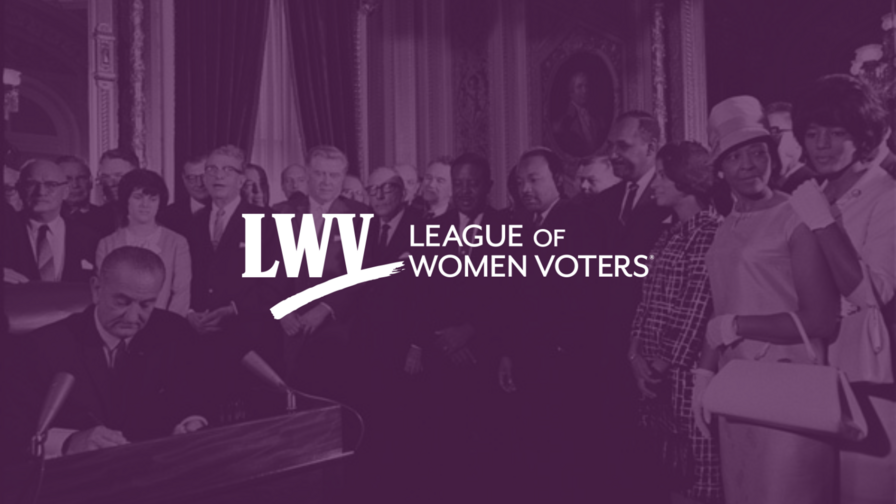The Latest Threat to the Voting Rights Act: Merrill v. Milligan (now Allen v. Milligan)
*On June 8, 2023, SCOTUS reached a positive ruling in this case, upholding a lower court ruling that Alabama must create a second majority Black congressional district in compliance with Section 2 of the Voting Rights Act. Read more.
This blog was written by legal intern Gabby Means
In the last decade, the US Supreme Court has severely weakened the Voting Rights Act of 1965 (VRA), which was widely agreed to be the most effective civil rights law in our history.
Beginning with its 2013 decision in Shelby County v. Holder, which gutted the VRA by rendering Section 5 ineffective, the Court has chipped away at the power of the VRA. Most recently, the Court weakened Section 2 of the VRA, one of the last protections against racially discriminatory voting laws. It did so in the 2021 decision in Brnovich v. Democratic National Committee, where the Court made it more difficult for voting rights plaintiffs to challenge racially discriminatory voting laws in court.
This term, the Court considers Section 2 again in Merrill v. Milligan. This time, the Court threatens to weaken well-established precedent lower courts have used for decades to evaluate redistricting plans alleged to be racially discriminatory. In this blog, we will explore the history of Section 2 and its impact on discriminatory redistricting plans, explain the dispute at issue in Milligan, and preview potential next steps to protect voting rights.
Background on the Voting Rights Act
The VRA was passed in response to deliberate efforts to prevent Black Americans from voting, including violence and terror. States — particularly in the South — were thwarting their pro-equality, anti-discrimination obligations under the Fourteenth and Fifteenth Amendments, and Congress determined further protections were required.

The VRA created remarkable remedies and protections to ensure that no one is prevented from participating in the political process because of their race. Its core protections are in Section 5 and Section 2 of the Act. Section 5 established a system of “federal preclearance,” which required jurisdictions with a history of racial discrimination in voting to seek preapproval before making any changes to their voting practices. For voters harmed by jurisdictions with racially discriminatory voting policies and practices, Section 2 provided them with legal recourse.
The Voting Rights Act was reauthorized — with strong bipartisan support — multiple times, most recently in 2006. But in 2013, the US Supreme Court held that the Section 5 coverage formula for determining which jurisdictions must submit to federal preclearance was not justified by current conditions. The decision essentially nullified Section 5 until a new coverage formula is passed in Congress (which has yet to occur). As the late Justice Ruth Bader Ginsburg noted in her dissent, “throwing out preclearance when it has worked and is continuing to work to stop discriminatory changes is like throwing away your umbrella in a rainstorm because you are not getting wet.” Unsurprisingly, since this decision, several restrictive state voting rights laws have been enacted.
Tell Your Representatives to Restore the VRA!
Section 2 of the VRA has always been critical to protect voters, but without a functioning Section 5, Section 2 is even more necessary to challenge policies and practices that intend to or effect of harming voters of color. As explored below, Merrill v. Milligan threatens Section 2 and voters’ ability to use it to challenge racial discrimination in voting.
Claims Under Section 2 of the Voting Rights Act: Vote Denial & Vote Dilution
Under Section 2(a) of the VRA, states may not pass any law that “results in a denial or abridgment” of the right to vote “on account of race or color.” Put simply, Section 2 prohibits any standard, practice, or procedure imposed or applied to deny or limit the right to vote based on race or color.
Support our work to defend voters' rights before SCOTUS
Cases brought under Section 2 have historically involved two types of violations:
1) Vote dilution; and
2) Vote denial.
Vote Denial
Vote denial claims typically challenge practices that render voting “not equally open to participation” for voters protected by Section 2 — racial and language minority groups. They became more common as states rushed to pass restrictive voting laws after the Shelby County decision. A common vote denial claim post-Shelby County are challenges to restrictive photo ID laws that disproportionately prevent voters of color from voting.
Until the ruling in Brnovich, the Supreme Court had not squarely addressed Section 2 vote denial claims. As noted in our previous blog, the Court in Brnovich dealt a blow to voters’ ability to challenge racial discrimination in voting under Section 2.
Vote Dilution
The most common and well-established use of Section 2 — and the claim raised in Milligan v. Merrill — is a vote dilution claim, raised in the context of redistricting and changes to jurisdiction boundaries. A violation of Section 2 occurs when states draw districts in a way that gives voters of color less power “to elect representatives of their choice.”
The earliest vote dilution cases concerned at-large voting; an election scheme used to drown out the power of voters of color. More recently, vote dilution claims have been brought to challenge redistricting plans that dilute the political power of Black residents and other communities of color on the local, state, and federal levels.
The Supreme Court has decided several vote dilution cases since the VRA was passed in 1965, including Thornburg v. Gingles in 1986, which established the test to evaluate claims of racial vote dilution in district boundaries. To establish a Section 2 violation under Gingles, plaintiffs must show that instead of the challenged map or boundaries which dilute the power of voters of color, an acceptable district could be drawn that would allow voters of color to elect a candidate of choice.
Merrill v. Milligan
On October 4, 2022, the Supreme Court heard oral arguments in Merrill v. Milligan. Plaintiffs — Alabama voters and voting rights organizations — challenged the congressional map passed by the Alabama legislature after the 2020 census. The new map maintained only one majority-Black congressional district out of seven total districts, despite the fact that 27% of the Alabama population is Black. This percentage suggests that there could — and, according to the Milligan plaintiffs, should — be two districts where Black voters can elect a candidate of choice. After the presentation of evidence, a three-judge panel at the district court found a likely Section 2 violation and irreparable harm to Black voters. The court ordered lawmakers to draw a new map that satisfies the requirements of Section 2.
Instead of accepting the ruling and working to address the violation on behalf of the state’s Black voters, the state filed an emergency appeal to the Supreme Court to halt the lower court order suspending Alabama’s map. The Supreme Court agreed, which meant that the Alabama congressional map, which a three-judge panel had struck down at the federal district court, would be in place for the upcoming 2022 election season. On October 4, 2022, the Supreme Court heard oral arguments.

Merrill v. Milligan is a straightforward vote dilution case, with an outcome dictated by Supreme Court precedent. As Justice Kagan noted during oral arguments, “this case should be a slam dunk.” Even Chief Justice Roberts agreed in his dissent to the emergency stay order, stating, “the District Court properly applied existing law in an extensive opinion with no apparent errors for our correction.” So why is the Supreme Court hearing this case?
The state argues that its “race-neutral” map — which only creates one majority-Black congressional district — should not be disqualified just because it is possible to draw two majority-Black districts in Alabama. They suggest that the VRA prohibits denying votes on account of race but does not affirmatively obligate states to redistrict on account of race. The state urges that the first prong of the Gingles test, that the community of color must be “sufficiently large and geographically compact to constitute a majority in a single-member district,” should be a race-blind test. Alabama’s argument does not square with the purpose and history of the VRA, which is specifically focused on rooting out racial discrimination in voting pursuant to Congress's power to enforce the Fourteenth Amendment.
Alabama voters in the Milligan case argue that Alabama violated Section 2 by “packing” and “cracking” Black residents to limit their political power. Importantly, they also argue that requiring the first prong of Gingles to be race-blind would defeat the purpose of Section 2, which is to protect voters of color from having their political power diminished. During oral argument, Supreme Court Justice Ketanji Brown Jackson acknowledged the historical importance of race in VRA case law, noting that “it became clear to me that the framers themselves adopted the equal protection clause, the Fourteenth Amendment, the Fifteenth Amendment, in a race-conscious way. That they were, in fact, trying to ensure that people who had been discriminated against . . . were brought equal to everyone else in the society.”
Learn More About Our Legal Cases
The League of Women Voters of Alabama and the League of Women Voters of the United States filed an amicus brief supporting Alabama voters in the case, along with the Southern Poverty Law Center and Stand-Up Mobile. The League’s brief urges the Supreme Court to uphold the district court ruling, which found a violation of Section 2. The brief explains how a second majority-Black district can be drawn to satisfy Section 2 by combining two communities in Alabama with deep ties to each other: the city of Mobile and Alabama’s Black Belt. The brief can be found here.
What's Next?
It's essential that the Supreme Court uphold the Alabama district court ruling and protect the longstanding protections Section 2 provides for voters. Should the Court rule in Alabama’s favor, future rulings striking down racially discriminatory redistricting plans could be put at risk. This is already occurring: in June 2022, a district court in Louisiana found a Section 2 violation for that state’s congressional map, but the decision has stayed pending the outcoming in Milligan. The racially discriminatory Louisiana congressional map has thus been allowed to go into effect for the 2022 election season. If the Supreme Court rules in favor of Alabama, the Louisiana case could suffer the same fate.
This case emphasizes the importance of restoring the Voting Rights Act to its full strength and passing federal voting rights protections. Encourage your representatives to do so: let Congress know they must pass the John Lewis Voting Rights Advancement Act and the Freedom to Vote Act to protect voters from discriminatory and suppressive voting practices.
A decision in Merrill v. Milligan is expected in the spring or summer of 2023.
The Latest from the League
LWVUS and LWV of Alabama stood in solidarity with Alabama voters in Merrill v. Milligan as it was heard before the US Supreme Court. Both Leagues had previously submitted an amicus brief in support of the Milligan plaintiffs.
On July 1, in Brnovich v. Democratic National Committee, the Supreme Court dealt a significant blow to the freedom to vote. The decision held that Arizona laws discounting ballots cast out of precinct and banning nonrelative neighbors or friends to deliver mail-in ballots did not violate the Voting Rights Act of 1965, despite these laws’ negative effects on Black and brown voters. It is a major loss for voting rights at a time when this sacred freedom is under attack across the nation.
The John Lewis Voting Rights Advancement Act will restore the Voting Rights Act and strengthen the freedom to vote.
Sign Up For Email
Keep up with the League. Receive emails to your inbox!
Donate to support our work
to empower voters and defend democracy.





